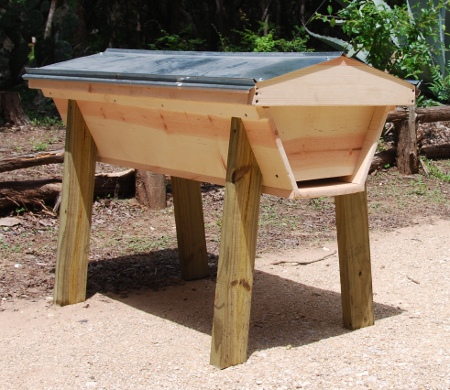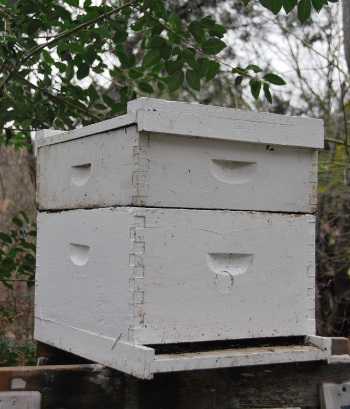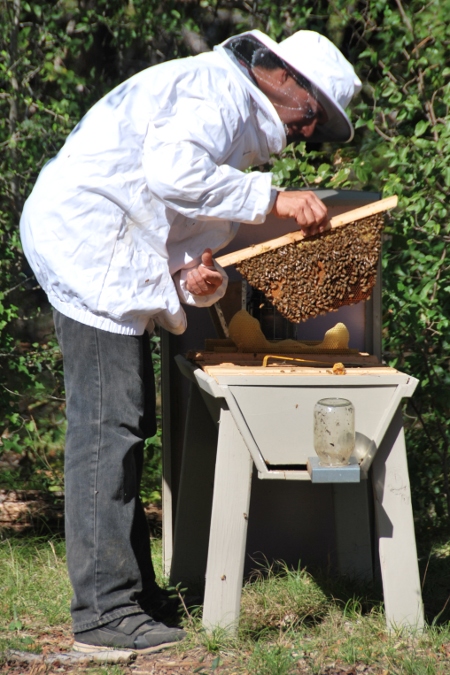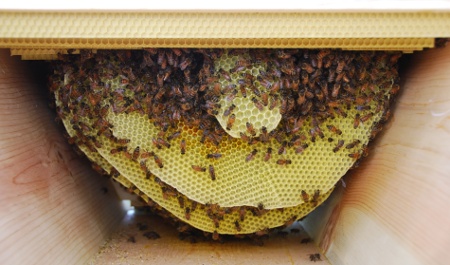Even if you’ve never kept bees yourself, you’ve probably seen Langstroth hives. Although Langstroths are the most widely used hive among commercial and hobbyist beekeepers, there’s another type of hive which offers a number of important advantages, particularly to the homesteader or small-scale beekeeper. This is the top bar hive.

As a beekeeper and a beekeeping teacher, I have kept both Langstroth and top bar hives for over twelve years and operated them side by side. In this article, I want to describe some of the differences between these two types of hives and show why I think the top bar hive is often the better choice on the homestead.

The Top Bar Hive
The focus of the top bar hive is on simplicity. It’s a single box hive. Unlike the Langstroth hive, which has multiple different boxes that you add or remove at different times of the year, the top bar hive is completely self-contained. Everything that the bees need to go through their yearly functions is contained in that one box.
The top bar hive differs from the Langstroth both in how the bees build their combs and in how we harvest the honey. Top bar hives have a protective roof. Under that roof, along the top of the hive, are 24 removable wooden bars. (That’s what gives the hive its name.) On each bar hangs a small starter strip, and it’s from there that the bees build their combs.
Langstroth hives, on the other hand, use a wooden frame for each comb. Each frame contains a factory-made foundation, which is a thin piece of wax that has been imprinted on both sides with a series of hexagons, on which the bees will build their cells. The bees will conform their cells to the size of the imprints on the foundation.

Harvest Your Honey with Household Utensils
When you harvest the honey from a top bar hive, it’s very simple. All you have to do is cut the honey comb off of the starter strip with a kitchen knife, mash it to open up the honey cells and use cheesecloth as a strainer to separate the wax from the honey. The nice thing about this, is you can do it all with very basic kitchen utensils, such as a bowl and a potato masher.
Harvesting honey from the Langstroth hive, on the other hand, requires several specialized tools: a hot knife or capping fork, a capping tank, and an extractor. These tools are expensive, and you’ll only use them for a short time each year while you’re harvesting honey. The rest of the time, they’ll sit idle. To keep bees with Langstroth hives, you’ll need a place to store this equipment, along with the extra hive boxes, and the frames and combs from which you extracted the honey, until you are ready to use them again. Storing the combs also invites a problem with wax moths.
Just the fact that the top bar hive contains everything your bees need for the entire year makes it a lot simpler to manage.
Better Control of the Varroa Mite
Back in the 1950’s, the manufacturers of the foundation material for Langstroth hives began using cell sizes that were slightly larger than what the bees would naturally build. The thinking at the time was that if the cell was larger than normal, the bees would start becoming larger than normal. But that’s not what happened – the bees stayed the same size. So now we have a large cell with a slightly smaller bee in it. Then the varroa mite hit in the 1960’s and 70’s. This mite lays eggs in the cell right about the time that the honeybee larvae is spinning its cocoon. The varroa mite goes through its metamorphosis and develops right along with the honeybee. The larger cell gives the varroa mite just the space that it needs to have a good-sized family. In fact, there will be as many as 3-7 varroa mites in each cell. Varroa mites can be very destructive to a hive, and if you don’t take measures to control them, they can destroy your colony.
The top bar hive helps reduce this whole problem in a very simple but effective way. When the bees build their cells the natural size, which they will do in the top bar hive, they’re just the right size for the developing honeybee. As the honeybee grows, it will fill its cell so completely that often any varroa mites in the cell will die for lack of room. You may still have some varroa mites, but not nearly as many as you’d have in the Langstroth hive, and usually, they won’t be a threat to your colony.
Better Overwintering
Because the top bar hive is horizontal, it holds heat much better than the Langstroth hive, and this makes it easier for the bees to overwinter. During cold weather, bees have to actively work to keep the hive warm. To provide the energy to do so, they consume honey. The Langstroth hive acts almost like a chimney. It is a stack of boxes, and since heat rises, most of the warm air rises to the top. This makes it hard for the bees to keep the lower sections of the Langstroth hive warm.
Improved Top Bar Hive Design
One difficulty we’ve encountered with the top bar hive is that during the hot summers of central Texas, the wax combs will soften in the heat, and they can break under their own weight. To overcome this problem, I’ve worked on the top bar design over the past twelve years to adapt it for our climate. I now have a design that has a shorter, wider comb, which works very well.
Another difficulty, one that beekeepers face each spring, is swarm control. When a bee hive swarms, it divides in two, and you end up losing half your colony. With this improved top bar hive design, there’s a way to manage the hive that prevents swarming and doubles the size of the pollination force. We go over this management technique in detail in our hands-on beekeeping workshop.
More Natural Comb Structure
The comb structure inside a top bar hive is very similar to the natural comb structure that honeybees would build in the wild, such as in a log. The queen is free to rotate through the colony and dictate how she wants to build her nest. She can use as much space as she needs to lay her eggs. Usually she’ll use 10-11 combs for brood (sometimes as many as 15). The rest will be available for honey.

In the Langstroth hive, on the other hand, you have to use a queen excluder to keep the queen down in the bottom two boxes because if you don’t, she will lay brood wherever she sees fit, and you’ll end up with combs that have both brood and honey, which would be a problem when it comes time to harvest the honey. Since you’re only giving the queen access to part of the hive, and since this is unnatural to her, you have to monitor how much space she needs, which is difficult to do.
Extra Wax for the Homesteader to Use
In the top bar hive, because you harvest the entire comb when you harvest the honey, you end up with extra wax. A lot of people who learn about the top bar are excited about the prospect of getting extra wax because there are many different uses for it. Every comb will give you about enough wax to make one candle. This may not sound like a lot, but when you’re looking at beekeeping and other homesteading activities from the viewpoint of a larger sustainable lifestyle and culture, the benefits of getting that extra wax are much higher than just returning it back to the bees, as you would in a Langstroth hive.
With the Langstroth hive, when you harvest honey, you cut the wax capping off of the comb with the comb fork or hot knife, and you leave the comb intact, so you’ll barely get a teaspoon of wax per comb. It would take quite a few Langstroth combs to get enough wax to make a candle.
Less Honey Production
The yield on a top bar hive is 3-5 gallons of honey a year versus the Langstroth hive, which will yield 5-10 gallons. For a commercial beekeeper, that’s an important consideration, and Langstroth hives will likely be your best choice, but if you’re looking to get into beekeeping on a smaller scale, as part of a sustainable lifestyle, and without a large investment of time and equipment, you really ought to consider learning more about the top bar hive.
Related Information
-
- Starting Your Top Bar Hive (Article)
- Essential Beekeeping Tools (Article)
